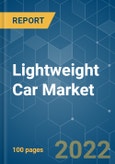The COVID-19 outbreak had a huge impact on the market. With the raw materials and international trade coming to a halt due to stringent lockdowns worldwide, the assembly lines and production units were closed, which considerably impacted the market. However, with the preference for personal and individual mobility, the market is set to stabilize in terms of revenue and market sizes of different vehicles.
Increasing demand for lightweight materials from the automotive industry and a growing focus on fuel economy are expected to be the major growth drivers for the market. However, the high cost of lightweight materials, such as carbon fiber and glass composites, is hindering the market's growth, as their usage in low-cost vehicles may drastically increase the prices of such vehicles.
The automotive sector is one of the largest markets for composite materials. The automotive industry is continuously looking for innovative materials to help reduce vehicle weight and achieve fuel efficiency and carbon emission targets.
Asia-Pacific is expected to witness the fastest growth in the market due to the growing automotive industry in the region (in terms of both production and demand), especially in countries, such as India and China. In India, the automotive industry is expanding rapidly, with the rise in the income level of consumers. In addition, the demand for light vehicles has increased with increasing awareness about fuel efficiency and environmental benefits. Currently, India is the fifth-largest producer of light and commercial vehicles and the second-largest producer of two-wheelers. With the rapid increase in manufacturing capacities in the country, the consumption of carbon fiber composites is expected to increase during the Forecasts period.
Key Market Trends
Increasing Demand for Lightweight Material from the Automotive Industry
As fuel costs and distance traveled are increasing, consumers want better miles per gallon (mpg) and often consider gas mileage as a key factor while purchasing a vehicle. With stringent emissions regulations due to increased exhaust emissions, automobile manufacturers are focusing on manufacturing lightweight vehicles to reduce CO2 emissions. A 10 kg weight reduction is estimated to save 1 gram of CO2 per kilometer. In the United States, the regulations mandate that, by 2025, the average fuel economy standard must meet 54.5 miles per gallon. As per the US Department of Energy (DOE), the vehicle's weight is being reduced by 10%, which may yield a 6-8% rise in fuel economy.
Thus, to facilitate this change, automobile manufacturers are shifting from steel or aluminum to composite materials essential to achieve the cost efficiency of these highly automated production cycles, which reduce vehicle weight. In a typical automobile, the use of fibers is 50% by volume while adding just 10% of the weight.
As a result, the companies have started using materials such as carbon fiber and titanium alloys to make vehicles lightweight and fuel-efficient, especially in luxury and sports models. Automotive manufacturers, such as BMW, Mercedes-Benz, McLaren, Chevrolet, and Lamborghini, are some of the OEMs continually increasing the usage of composites in their vehicles as they aid in reducing the weight of the vehicles.
Europe is Expected to Witness Healthy Growth Rate
With the enactment of stringent emission norms and fuel economy standards in Europe, automobile manufacturers in the region have started using carbon fiber composites for manufacturing their vehicles.
The companies are experimenting with new composites that can reduce the total weight of the vehicle to a great extent. The application of carbon-fiber-reinforced plastic (CFRP) has been widely adopted for the production of automotive bodies, particularly in German cars such as BMW and Audi.
For instance, BMW partnered with German carbon fiber producer SGL Group and invested ~USD 1 billion for securing the supply chain for CFRP used in the production of i3 and i8. Apart from BMW, another German automobile manufacturer, Audi, uses CFRP to produce the rear wall of the space frame for its A8 luxury sedan. This part provides ~40% of the vehicle’s overall torsional rigidity, making it a suitable material for usage in the vehicle. The part is ~50% lighter in weight than its metallic predecessor.
The carbon fiber material is a go-to option for most manufacturers. Despite being a lightweight material, it can handle high loads and is a perfect alternative to traditional heavy-weight metals.
Competitive Landscape
Some of the major players in the lightweight car market are Toyota Motor Corporation, Nissan Motor Co. Ltd, Kia Motors Corporation, Hyundai Motor Co., and Ford Motor Company.
Auto manufacturers majorly dominate the market for lightweight cars. They also have a long-standing partnership with major composite manufacturing companies.
Additional Benefits:
- The market estimate (ME) sheet in Excel format
- 3 months of analyst support
This product will be delivered within 2 business days.
Table of Contents
Companies Mentioned (Partial List)
A selection of companies mentioned in this report includes, but is not limited to:
- Toyota Motor Corporation
- Volkswagen
- Ford Motor Company
- Hyundai Motor Co.
- Nissan Motor Co. Ltd
- General Motors Company
- Honda Motor Co. Ltd
- Kia Motors Corporation
- Ferrari SpA
- Lamborghini SpA
Methodology

LOADING...








